Trigger Point Therapy
A Trigger Point is an area of muscle tightness causing tenderness or pain when pressed on. It interferes with normal muscle function which can include:
- Decreased normal range of motion
- Muscle weakness
- Referral pain to other parts of the body.
- Numbness
- Tingling
- Burning sensation
- Muscle spasms
- Avoids scar tissue formation
- Promotes better circulation
Trigger point therapy uses the hand, fingers, elbow, or small hand device to find tight bands or nodules of muscle fibers. Once found, trigger points are compressed with sustained pressure to relax it. They relax in seconds or several minutes. I find the first-time trigger point therapy is done takes the longest to relax. Future sessions, the trigger points relax quicker much to the amazement of the patient.
As a chiropractic student, I got interested in trigger point therapy due to my own case. In student clinic, I learned my body responded very well to it. I was so impressed, when it came time to take our required trigger point classes I was ecstatic to learn so patients could experience what I had. I even had my professors asking me to work on them. I love to hear patients say, “This is going to sound funny, but it hurts and feels good at the same time.” As soon as they state, “This is going to sound funny,” I know what is going to come out of their mouth. This in itself is a very good indicator their problem is going to resolve using trigger point therapy. Another good indicator is “This reproduces the pain, numbness, tingling, or burning sensation I am dealing with.”
My most favorite case was a senior citizen who had been dealing with sciatica for 3 years. During her exam, several trigger points were found in the low back and buttocks muscle. The culprit in her case was the piriformis muscle. The sciatic nerve can run underneath this muscle or directly through the piriformis muscle. After 3 sessions of trigger point therapy and chiropractic adjusting, her pain started to fade away. Initially, she had an injury to her low back and the muscles stiffened to stabilize the area. As an injury heals, most of the time the muscles relax rather than continuing to act like a splint. In her case, her piriformis did not let go and caused her to have sciatica.
Most Common Trigger Points Worked in My Practice
Head and Neck
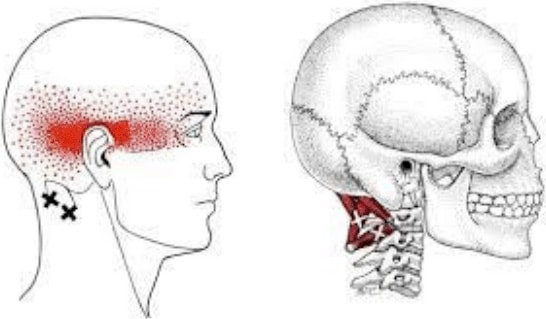
Suboccipital muscle trigger points lie just below you skull in the back. Here I use my fingers to compress them. These can cause headaches, overall tightness in the neck, and pain in the red area known as a referral pattern, which all trigger points are notorious for.Posterior cervical muscle trigger points are on each side of your neck. I also use my fingers to compress these. They can cause headaches, overall tightness in the neck, and pain in the red area known as a referral pattern.
Posterior cervical muscle trigger points are on each side of your neck. I also use my fingers to compress these. They can cause headaches, overall tightness in the neck, and pain in the red area known as a referral pattern.
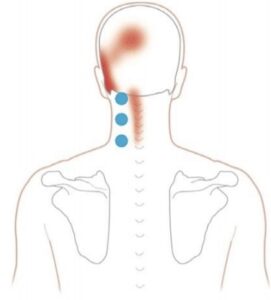
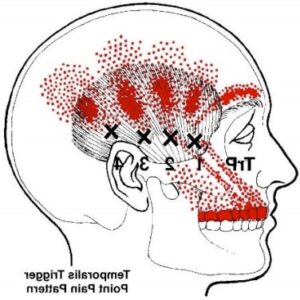
TMJ muscle trigger points are on each side of your head. Fingers are used to compress them. The trigger points can cause headaches, pain around the ear, problems chewing, and clicking noise at ear area.
Shoulder Area
Levator Scapular muscle trigger points can give people a lot of discomfort. The X’s are where I would use my elbow to compress these trigger points. Everyone is so shocked by the pain they create when pressure is applied but happy at the same time because the pressure feels so good to the trigger point. Some patients will feel numbness into their corresponding arm that diminishes as the trigger point is broken up.
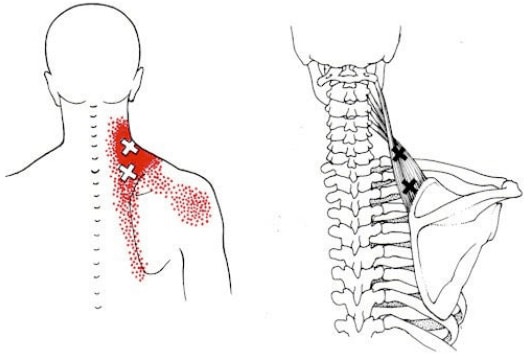
Low Back Area
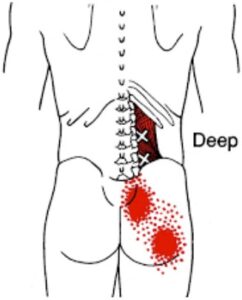
The Quadratus Lumborum muscle trigger points, especially the bottom X creates a ton of low back pain. This is another spot people say it feels good and hurts at the same time, as I am applying pressure using my elbow. I have had patients come in limping and leave walking normally or came in bent over and left standing up straight.
Piriformis muscle trigger points are notorious for causing sciatica. This causes pain to radiate down your leg. I usually see the pain stop at the knee, but it can go all the way down to the toes. This is another spot it can feel good and hurt at the same time. I like to give patients with sciatica a stretch for the piriformis muscle. The nice thing about this stretch is it can be done sitting, so patients are more apt to do it.
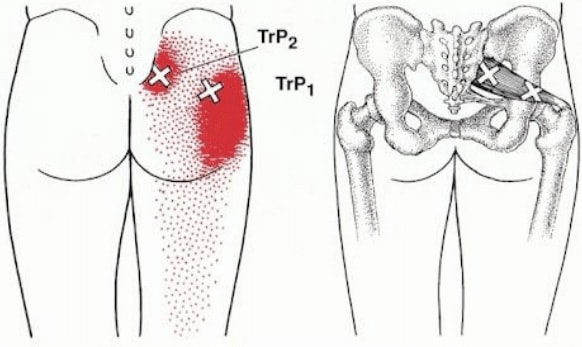
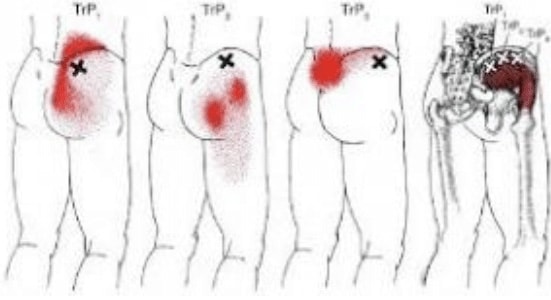
Gluteus Medius muscle trigger points can be a contributing factor for eliminating sciatica. The quadratus lumborum, piriformis, and gluteus medius trigger points definitely get worked on with any patient with sciatica.
I encourage my patients to use 2 tennis balls in a sock (they are already made at our office for purchase) to home treat trigger points. I stumbled across this during student clinic in which we work on the student population. After completion, we are in outpatient clinic working on the public for a full year.
Relieving these trigger points are huge. Sometimes a muscle becomes tight causing misalignment or subluxation of your spinal joints or joints in your extremities (feet, knees, shoulders, elbow, wrists, hands). By the way there can be trigger points in the extremities too. It can happen where the misalignment occurred first, then the muscle gets affected and tightens up. It like “Did the chicken or the egg come first?”
There are only two side effects I see from time to time. There are some people who bruise from trigger therapy, and they are most times the ones who say they bruise easily anyways. Trigger point therapy can cause nausea and even vomiting. This is because the muscle is knotted and prevents toxins from flowing through the muscle. As the knot is broken up, fresh blood is now able to flow through the area where the knot had been. These toxins can make some people nausea, even to the point of throwing up. This is why it is so important to drink plenty of water to help push the toxins out of your body.
